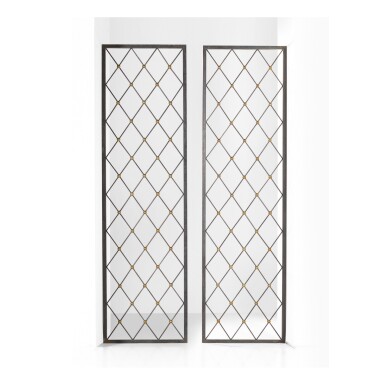Important Design
Important Design

JEAN ROYÈRE | PAIR OF “TOUR EIFFEL” ROOM DIVIDERS
Auction Closed
July 30, 06:21 PM GMT
Estimate
25,000 - 35,000 USD
Lot Details
Description
JEAN ROYÈRE
PAIR OF “TOUR EIFFEL” ROOM DIVIDERS
circa 1950
patinated iron, brass
83⅞ x 23¾ x 1 in. (214 x 60 x 2.7 cm) each
Phillips London, April 25, 2013, lot 79
Acquired from the above by the present owner
Jean Royère: décorateur à Paris, exh. cat., Musée des Arts Décoratifs, Paris, 1999, p. 101 (for a gouache drawing of the model)
Pierre-Emmanuel Martin-Vivier, Jean Royère, Paris, 2002, p. 128 (for a drawing of a related model)
Galerie Jacques Lacoste and Galerie Patrick Seguin, eds., Jean Royère: Volume 1, Paris, 2012, p. 144 (for the above mentioned drawing)
Galerie Jacques Lacoste and Galerie Patrick Seguin, eds., Jean Royère: Volume 2, Paris, 2012, p. 79 (for a related door model)
While Royère first introduced the idea of the crossed bars joined by spheres in 1939, it was not until his 1947 exhibition at the Résidence Française that the shape was clearly defined by means of a low table and a table lamp. The “Tour Eiffel” motif, as it is known and of which the present lot is a prime and monumental representation, was the result of endless decorative experimentations and epitomizes Royère’s sense of timeless sophistication. The combination of painted crossbars and central brass or bronze globes was delineated across a variety of furniture pieces including coffee tables, mirrors, fireplace screens, console tables and a wide range of lamp forms, often combined together in homogenous ensembles. At the French consulate in Alexandria, Egypt, Royère furnished an entire room in the "Tour Eiffel" style, which perhaps constitutes his best interpretation of the motif. The present lot is a rare iteration of the celebrated motif and was likely created in the context of a private commission. Other room dividers in this style are documented through photographs and drawings from the archives of the artist, such as a curved variant of the present model designed for a dining room.
